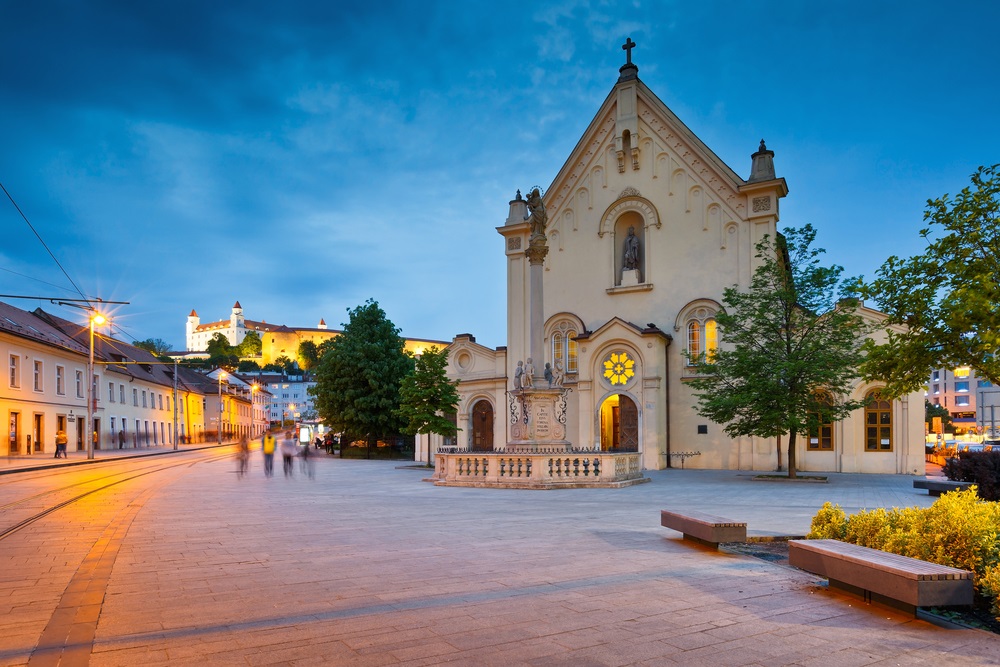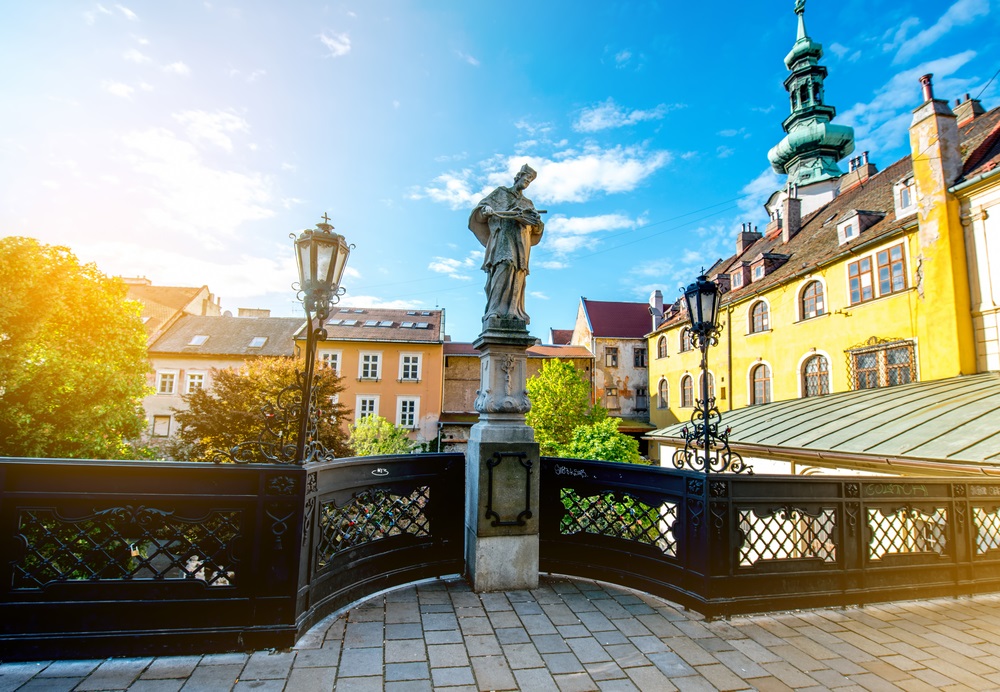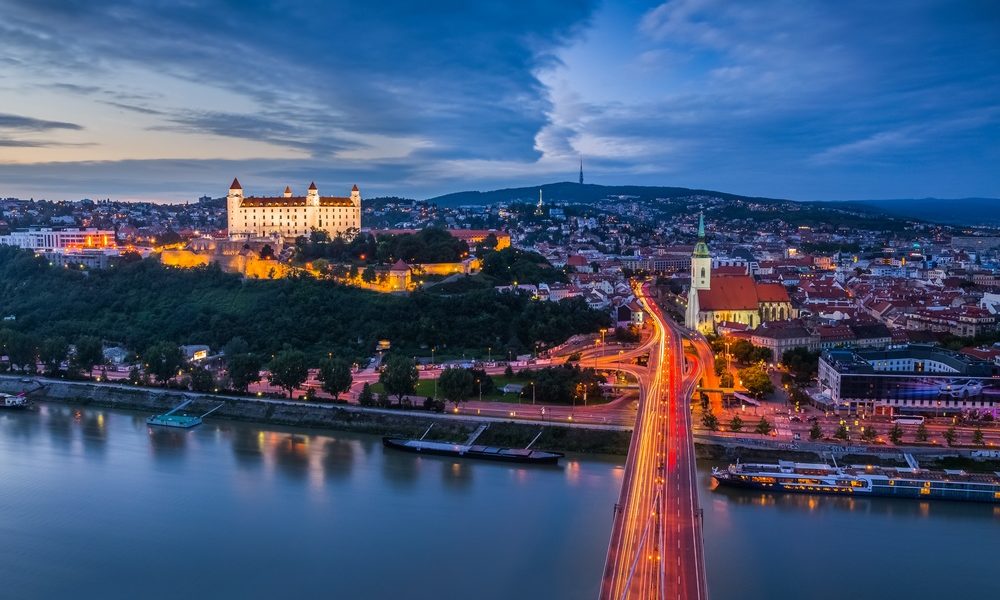Bratislava is the capital of Slovakia, resting right on teh edge of the Danube River. A city rich in history and culture, Bratislava is over 1,100 years old, but has had residents as early as 5000 BC! Founded during the rise of the earliest Slavic empire, Samo’s Empire, the city grew over the ages as it struggled against the neighboring kingdom of Hungary, which is was eventually incorporated into, but still remained relatively autonomous and free. In the 16th century it even became the kingdom’s capital and the coronation town for its royalty.
WWI sparked are period of turmoil after the city was made a part of Czechoslovakia against its residents will, as well as under Nazi Germany’s control in WWII and Soviet Russia after the war. Despite this, the city grew throughout this period as a national identity formed among the Slavic people who established it as the official capital of the Slovak Republic in 1993 following the dissolvement of Czechoslovakia.
But who is Bratislava?
Bratislava is an ancient and young city, a city shaped by numerous political and cultural influences while building itself up as a major economic center in Europe, complete with its own identity. Despite its importance, it is also relatively small, with a population of only 450,000, but with new investments and the interests of global organizations the city is gradually growing. Complete with gorgeous architecture, lovely museums and concert halls, and a complex but enticing history, Bratislava is one of the jewels of Eastern Europe.
Getting to Bratislava
Bratislava rests just on the border between Austria and Slovakia, just an hour from Vienna, and 20 minutes north of Hungary. The Danube River cuts the city in half, the northern portion being largely devoted to Old and New Bratislava, contrasted by the historic medieval buildings and rising skyscrapers. Because of its location, it is a major travel hub for any trip to Eastern and Central Europe. Even if its only for a night, the city is well worth a visit (and many more). Bus tours from as far as Frankfurt allow inexpensive trips to the city and its neighboring countries.
Three major highways run through the city: the D1, which provides access east to the rest of Slovakia; the D2, which runs north and south to Prague, Brno, and Budapest; and the A6 which connects Slovakia to Vienna and the Austrian highway system. It is also a major railway hub, with the Main Station in the Old Town providing rides all throughout Europe, including Germany, Poland, Russia, and Croatia.
If you’re flying in, then M.R. Stefanik Airport is your go to option, which accepts flights from all over the world. If you want a scenic trip, then you can cruise down the Danube River from Vienna.
Weather in Bratislava

Keeping with the duality of the city, Bratislava is capable of supporting two seasons at once. Because the city is hilly in one half and flat in the other, each region will experience different climates at the same time. Late winter can include a ski trip for one traveler while another can smell freshly blooming flowers on the other side of the city.
However, that doesn’t mean the city disobeys the gods of weather. Winter is still cold, Summer warm, and Spring and Fall up to their same old business. Summer – Late May to August – offers relatively warm weather with plenty of sunshine, sparking a lot of activity throughout the city from music and art festivals that take to the streets with the closure of the concert halls to lively markets and historic festivals, such as the annual Coronation festivities.
The events don’t stop with the rise of Fall; instead, they get more active! Running from September to November, the weather meets a middle ground and the summer tourists depart, but the city doesn’t stop celebrating, especially with wine harvest season in full swing. November 11th, the day of St. Martina, is the best time to visit, as it is the official point where the new wine can be tasted and sold. The music festivals also continue with Waves, Bratislava Jazz Days, and the Bratislava Music Festival, which hosts more classical performances.
Winter is typically cold and sometimes experience snowfall, but not too often. Warm clothes are suggested but don’t expect to get snowed into your hotel. Instead, keep a nice outfit on hand in case you get invited to a Christmas or New Years party, which are quite festive! Make sure to try the local spirits of Slovakia including the warm drinks that can’t be found anywhere else in the world.
And finally, Spring. Beginning between February and March, the city shakes off the cold and its many, many green spaces bloom with colorful flowers. Take a stroll through the Bratislava Botanical Garden or wander through the surrounding forests to enjoy the peace of nature. And keep your plate ready for the return of the farmer markets and the fresh fruits beckon the rise of a variety of food festivals that will entice every foodie around.
Top Attractions in Bratislava

We’ve mentioned Bratislava’s history, its weather, its diversity, but we have to talk about the food. Bratislava is a foodie paradise with delicious, local and fresh products flowing into the city at all times. Mixed together from Hungarian, Austrian, German, and Slovak tastes, Slovakia doesn’t really have one type food, but a buffet of options. You’ll find a variety of meats, from a signature plate of roasted goose, alongside some delicious soups with a healthy addition of potatoes. If you want a real foodie experience, head down to Eurovea Gallery on the Danube which has a grown collection of great and trendy restaurants. And don’t miss the chance to discover the amazing wine of Small Carpathian while you’re at it.
And once you’ve filled your belly its time to explore this great city, either on your own or with an all encompassing sightseeing tour. Where to start?
Well, the shining Bratislava Castle is without a doubt a must on every trip, both from its gorgeous architecture and sprawling history. The UFO Tower, especially at night, is another great attraction worth a visit, alongside St. Martin’s Cathedral. The old town hosts numerous well preserved medieval buildings and alleyways that are just waiting for you to wander through.
The city is very active and perfect for joggers or cyclists who want to keep their adrenaline pumping while seeing the sights. With various parks riddled through it you can easily spend a morning exploring the city while getting in your daily run. Those looking for a bit more can try bungee-jumping from the UFO Tower or kayak on the Danube.
The artists will adore Bratislava , with over 50 museums, 30 theaters, and 20 galleries. Take in a show at the Slovak National Theatre or explore the finely decorated halls of the Slovak National Gallery. VisitBratislava has made an invaluable guide to the many museums and galleries of Bratislava that is well worth a look through.
Whatever you pack into your trip,make sure to relax and enjoy yourself in this jewel of the city.
| Dollar | Euro |
| Language | Slovak, some English, Hungarian and Czech |
| Cultural Etiquette | Privacy is highly valued in Slovakia and require time and trust to warm up to strangers. Tourists will find them very formal and reserved, but not rude or unhelpful. Most will not speak your first name until after becoming close friends, so its best to refer to everyone by their title and surname.
Most greetings are warm, but expect firm handshakes and direct eye contact instead of a hug. If you’re invited to someone’s home (which is rare unless you’re a close friend), make sure to bring wine, chocolates, or flowers. Also, remember to arrive on time, remove your shoes at the door, dress well, and eat everything on your plate. For more tips on cultural etiquette in Slovakia check out Commisceo Global’s guide. |
| Food | Due to their proximity to Hungary and Austria, you’ll find a lot of their influences on the cuisine. Most meals will incorporate some form of cabbage, pork, rice, and/or potatoes. Major meals will feature fruit as a side dish. Meat is a large part of most meals, making it a little rough for traveling vegetarians.
That being said, there are many options including Bryndzove halusky (boiled potato dough and cheese), garlic soup, and various fried cheeses and vegetables. |
| Restaurant Etiquette | Tipping in restaurants or for services is not a common practice in Slovakia but its generally expected from tourists. 10-15% is a safe number to use for tips.
However, guests are expected to tip at bars, especially after a round of drinks. |
| Safety Level | Generally safe, but there are pick pockets and petty crimes throughout the city. For individuals traveling at night it is best to remain in a group and be away of the night ride routes.
And no, it is nothing like “Hostel.” |
| Getting Around | The city’s public transit system is known as MHD (Municipal Mass Transit) and allows travelers to buy tickets at the ticket stops from kiosks before a bus, trolleys or tram arrives.
It is highly suggested you buy the 60 minute transfer ticket for EUR 0.90 instead of the 15 minute one way ticket. They’re more valuable for the cost and are helpful if you’re stopped by a ticket inspector (who are rather strict with tourists). More information about public transport can be found on the official MHD website, including details about finding accessible public transport, night routes, and how to get to popular destinations. |
| Emergency Services | Police: 158 Firemen: 150 Ambulance: 155 SOS: 112 |
| Additional Resources | Visit Bratislava has plenty of information regarding events, accommodation, and itinerary suggestions. |
Ready to get Tours4fun travel deals & tips straight to your inbox? It’s Free! Follow the fun and sign up today






There are no comments.